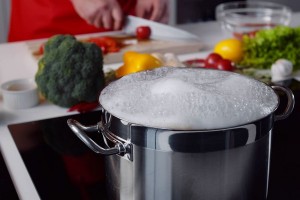The best thing you can do for your cooking is leave your food alone
 Close-up of water boiling in a pot (Getty Images/Nimito)
Close-up of water boiling in a pot (Getty Images/Nimito)
--
Shares
Facebook Twitter Reddit Email
A few years back, I was attending an after-work hangout with some colleagues back at one of their apartments. I recall a colleague of mine was standing at the stove, making meatballs.
Now, it was not my kitchen, not my meatballs and not my stove, so I kept quiet, but I watched with a twitching eye as she repeatedly moved the meatballs with her tongs and her spoon. And when I say repeatedly, I mean legitimately every two to three seconds. It was maddening. The meatballs were falling apart in the pan, there was not nearly enough fat in the pan for the meatballs to cook in, and worst of all, there was no way for the meatballs to get that deep brown, crisp crust that every good meatball must have.
Related
Salt is a necessity in every recipe. Black pepper is not. Here’s why
I think back to this moment every once in a while because it cemented something that I hadn’t thought of prior to it: People love moving their food around as it cooks. Now, don't get me wrong, sometimes this is necessary. Pasta is a prime example. But when cooking most proteins or vegetables, that just isn't the case, which is why I've realized that one of the best things you can do for your cooking — is leave your food alone.
When you’re incessantly playing with your food as it cooks, you’re depriving it well-earned time for the surface area of the food — no matter what it is — from browning and crisping in direct contact with the fat and the hot pan itself. Stop doing that!
We need your help to stay independent
Subscribe today to support Salon's progressive journalism
I get it: Some people get spooked about their food not cooking through entirely, of food poisoning, of undercooked meat and so on and so forth. But in many instances, flipping or moving your food every 15 seconds isn't helping assuage those concerns at all. If anything, the preferable approach here would be to crisp and brown the heck out of whatever you're cooking before throwing it in the oven for five or ten more minutes to ensure the center is fully cooked through.
One of my all-time favorite chicken cooking techniques comes from the Battersby cookbook, "Battersby: Extraordinary Food from an Ordinary Kitchen" by chefs Joseph Ogrodnek and Walker Stern, as well as writer Andrew Friedman (the restaurant itself closed in late 2018, just days after my first visit there).
Ogrodnek and Stern's recipe for "Pan-roasted chicken with summer fruit panzanella" — which is probably one of my favorite recipes I’ve ever made — requires a very particular process for the chicken that requires lots of patience. As the book instructs:
“Season the chicken breasts all over with salt and pepper. Heat a cast-iron skillet until very hot and add 2 tablespoons of the olive oil. Ad the breasts, skin-side down. When the oil begins to shimmer again, 8 to 10 minutes, add the butter, thyme, and garlic to the pan. Baste the chicken with the melted butter for 2 to 3 minutes. Transfer the pan to the oven and cook until cooked through . . . 8 to 10 minutes more . . . Remove the pan from the oven and return to the stovetop over medium-heat heat. Turn the beasts over and cook for 1 minute, then transfer the chicken beasts to a cutting board and let rest for 5 minutes."
Generally, I almost never abide by the precise instructions of a savory recipe. The first time I made this recipe, though, I did just that. And now every time I’ve made it since, I follow these intricate instructions to a T.
Want more great food writing and recipes? Subscribe to Salon Food's newsletter, The Bite.
In this instance, and in many cooking instances, the patience is the key. It’s fascinating to think that the challenging aspect here might be to do nothing, but that’s entirely the point.
The end result of this method is the most jarringly moist, juicy chicken with a skin that is crispy like you’ve never, ever had. It is genuinely stupendous and my favorite way to cook skin-on, boneless chicken breasts. Also, the salad that’s served alongside is mind-bogglingly good, but that’s a conversation for another day.
As my coworker showed, it’s tempting to shift and move and turn your food, but seriously, don't mess with it so much. Put the tongs down. Read a few pages of a book. Go cuddle with your dog. Put on some music. Scroll through the site-formerly-known-as-Twitter. Whatever! Just step away from the stove for a minute, let your food acquaint itself with the cooking vessel and give yourself a lil’ break (and can’t we all use one of those?). In so many instances, there's just no need to stand at the stove nursing it, so . . . just stop doing it.
Trust me. Your food will be immensely better. You'll exercise some patience. And you’ll get be able to get off your feet for a moment. It’s a win-win.